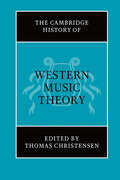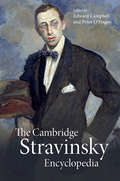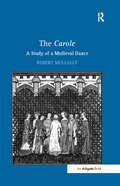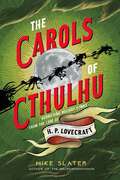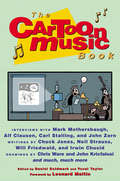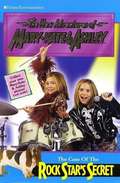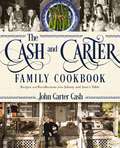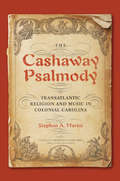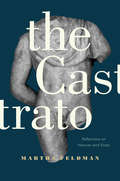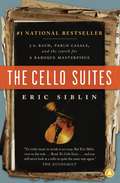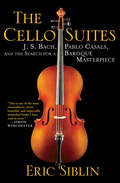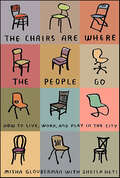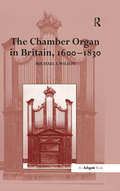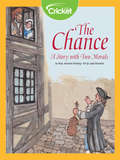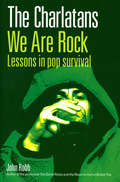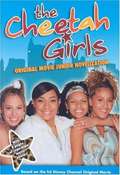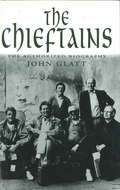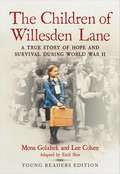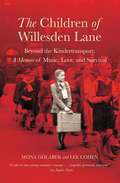- Table View
- List View
The Cambridge History of Western Music Theory
by Thomas ChristensenThe Cambridge History of Western Music Theory is the first comprehensive history of Western music theory to be published in the English language. <p><p>A collaborative project by leading music theorists and historians, the volume traces the rich panorama of music-theoretical thought from the Ancient Greeks to the present day. Recognizing the variety and complexity of music theory as an historical subject, the volume has been organized within a flexible framework. Some chapters are defined chronologically within a restricted historical domain, whilst others are defined conceptually and span longer historical periods. Together the thirty-one chapters present a synthetic overview of the fascinating and complex subject that is historical music theory. Richly enhanced with illustrations, graphics, examples and cross-citations as well as being thoroughly indexed and supplemented by comprehensive bibliographies of the most important primary and secondary literature, this book will be an invaluable resource for students and scholars alike.
The Cambridge History of World Music
by Philip V. BohlmanScholars have long known that world music was not merely the globalized product of modern media, but rather that it connected religions, cultures, languages and nations throughout world history. The chapters in this History take readers to foundational historical moments – in Europe, Oceania, China, India, the Muslim world, North and South America – in search of the connections provided by a truly world music. Historically, world music emerged from ritual and religion, labor and life-cycles, which occupy chapters on Native American musicians, religious practices in India and Indonesia, and nationalism in Argentina and Portugal. The contributors critically examine music in cultural encounter and conflict, and as the critical core of scientific theories from the Arabic Middle Ages through the Enlightenment to postmodernism. Overall, the book contains the histories of the music of diverse cultures, which increasingly become the folk, popular and classical music of our own era.
The Cambridge Stravinsky Encyclopedia
by Edward Campbell Peter O’HaganIgor Stravinsky is one of a small number of early modernist composers whose music epitomises the stylistic crisis of twentieth-century music, from the Russian nationalist heritage of the early works, the neo-classical works which anticipate the stylistic diversity of the contemporary musical scene in the early twenty-first century and the integration of serial techniques during his final period. With entries written by more than fifty international contributors from Russian, European and American traditions, The Cambridge Stravinsky Encyclopedia presents multiple perspectives on the life, works, writings and aesthetic relationships of this multi-faceted creative artist. This important resource explores Stravinsky's relationships with virtually all the major artistic figures of his time, painters, dramatists, choreographers and producers as well musicians and brings together fresh insights into to the life and work of one of the twentieth century's greatest composers.
The Cambridge Verdi Encyclopedia
by Roberta Montemorra MarvinVerdi's enduring presence on the opera stages of the world and as a subject for scholarly study by researchers in various disciplines has placed him as a central figure within modern culture. The composer's undisputed popularity from the mid-nineteenth century to the present day, among enthusiasts and scholars alike, lies at the heart of The Cambridge Verdi Encyclopedia. This comprehensive resource covers all aspects of Verdi's music and his world, including the people he knew and worked with, his compositions, and their reception. Extensive appendices list all of Verdi's known works, both published and unpublished, and the characters in his operas. As a starting point for information on specific works, people, places, and concepts, the Encyclopedia reflects the very latest scholarship, presented by an international array of experts in a manner that will have a broad appeal for opera lovers, students, and scholars.
The Cambridge Wagner Encyclopedia
by Nicholas VazsonyiRichard Wagner is one of the most controversial figures in Western cultural history. He revolutionized not only opera but the very concept of art, and his works and ideas have had an immeasurable impact on both the cultural and political landscapes of the late nineteenth and twentieth centuries. From "absolute music" to "Zurich" and from "Theodor Adorno" to "Hermann Zumpe," the vividly-written entries of The Cambridge Wagner Encyclopedia have been contributed by recognized authorities and cover a comprehensive range of topics. More than eighty scholars from around the world, representing disciplines from history and philosophy to film studies and medicine, provide fascinating insights into Wagner's life, career, and influence. Multiple appendices include listings of Wagner's works, historic productions, recordings, and addresses where he lived, to round out a volume that will be an essential and reliable resource for enthusiasts and academics alike.
The Carnival of the Animals
by Jack PrelutskyA great way to introduce children to classical music.America&’s first Children's Poet Laureate has written all-new verses to accompany the composer Camille Saint-Saëns&’s The Carnival of the Animals, and the illustrator of the Harry Potter books has turned these rollicking rhymes into a picture-book fun fest. A note to parents and teachers by Judith Bachleitner, head of the music department at the prestigious Rudolf Steiner School in New York City, suggests ways preschoolers can act out the music—tromp like an elephant, hop like a kangaroo, glide like a swan—or, for older children, be creatively inspired by this joyful work.
The Carole: A Study Of A Medieval Dance
by Robert MullallyThe carole was the principal social dance in France and England from c. 1100 to c. 1400 and was frequently mentioned in French and English medieval literature. However, it has been widely misunderstood by contributors in recent citations in dictionaries and reference books, both linguistic and musical. The carole was performed by all classes of society - kings and nobles, shepherds and servant girls. It is described as taking place both indoors and outdoors. Its central position in the life of the people is underlined by references not only in what we might call fictional texts, but also in historical (or quasi-historical) writings, in moral treatises and even in a work on astronomy. Dr Robert Mullally's focus is very much on details relevant to the history, choreography and performance of the dance as revealed in the primary sources. This methodology involves attempting to isolate the term carole from other dance terms not only in French, but also in other languages. Mullally's groundbreaking study establishes all the characteristics of this dance: etymological, choreographical, lyrical, musical and iconographical.
The Carols of Cthulhu: Horrifying Holiday Hymns from the Lore of H. P. Lovecraft
by Mike SlaterSummon a dark Noel or haunted Hanukkah with twisted takes on classic songs for everyone on your naughty list. Whether you’re home for the holly-daze or wandering a hellish landscape of never-ending agony, you need a good tune to pass the time. The dire duo behind the best-selling The Necronomnomnom accordingly present a gruesome grimoire of 25 creepy carols and sinister songs. From “Do You Fear What I Fear?” to “It’s Beginning to Look a Lot Like Mythos” and “Shoggoth the Formless Horror” to “Silent Knife,” “Sunken Hells,” and “The Twelve Days of Darkness,” these puntastic parodies pay hellacious homage to the Lovecraftian cosmos. Shriek them bleakly into the vast abyss or brandish them at seasonal gatherings to revile your fellow revelers. This disquieting collection of chants and canticles features extraordinary illustrations and desperate strains from the throats and hands of those who have gone before. Its harmful harmonies and ruinous rhythms will engulf your mind for all the days of darkness to come. Make merry while you can.
The Cartoon Music Book
by Daniel Goldmark Leonard Maltin Yuval TaylorThe popularity of cartoon music, from Carl Stalling's work for Warner Bros. to Disney sound tracks and The Simpsons' song parodies, has never been greater. This lively and fascinating look at cartoon music's past and present collects contributions from well-known music critics and cartoonists, and interviews with the principal cartoon composers. Here Mark Mothersbaugh talks about his music for Rugrats, Alf Clausen about composing for The Simpsons, Carl Stalling about his work for Walt Disney and Warner Bros., Irwin Chusid about Raymond Scott's work, Will Friedwald about Casper the Friendly Ghost, Richard Stone about his music for Animaniacs, Joseph Lanza about Ren and Stimpy, and much, much more.
The Case Of The Rock Star's Secret (The New Adventures of Mary-Kate and Ashley)
by Melinda Metz Mary-Kate Olsen Ashley OlsenCrank it up! Ashley and I were in a rock band! We were practicing for our first concert--and we were jammin'! We couldn't wait to blow the crowd away! But then weird stuff started happening. Someone replaced our singer's shampoo with black hair dye. A huge explosion went off outside our dress rehearsal. And all our instruments disappeared--right before the concert! Who was trying to stop the music? We had to find out--fast!
The Cash and Carter Family Cookbook: Recipes and Recollections from Johnny and June's Table - Cooking with Johnny Cash – Southern Comfort Food and International Meals from the Man in Black
by John Carter CashEnjoy Johnny&’s favorite recipes and get behind-the-scenes stories of life around the Cash-Carter family dinner table.People all over the world loved Johnny Cash and June Carter Cash for their charismatic stage presence and soul-stirring music but those who knew them personally remember them best for their warm hospitality and the meals from their kitchen. Family, friends, and fellow artists were always welcomed to a beautiful table set with June's fine linens, china, and crystal to enjoy Southern comfort food and also international dishes the couple gathered on tours around the world.In The Cash and Carter Family Cookbook, John Carter Cash shares the stories and recipes that flowed from his family's dinner table including:Johnny Cash's Iron-Pot Chili with a Roasted TopJune's Walnut and Grape Chicken SaladMother Maybelle Carter's Tomato GravyRoast Leg of Lamb with Garlic Crust and Fresh Mint SauceSpanish Seafood and Chicken PaellaCash and Carter Ring of Fire Barbecue SauceJohnny's Pinto Beans and Ham HocksJune's New York-style Cheesecake with Fresh Berry Compote The family favorites collected here are perfect for an intimate gathering or for hosting a crowd and include recipes for main courses, appetizers, side dishes, desserts, sauces, and late-night snacks. In addition, the book contains the memories and reminiscences of the musicians and film stars welcomed in the home, from Loretta Lynn and Adam Clayton of U2 to Jane Seymour and Billy Bob Thornton.The Cash and Carter Family Cookbook is the perfect gift for Carter and Cash fans as well as anyone who wants to experience the love, comfort, and hospitality of sitting at Johnny and June's table.
The Cashaway Psalmody: Transatlantic Religion and Music in Colonial Carolina (Music in American Life #489)
by Stephen MariniSinging master Durham Hills created The Cashaway Psalmody to give as a wedding present in 1770. A collection of tenor melody parts for 152 tunes and sixty-three texts, the Psalmody is the only surviving tunebook from the colonial-era South and one of the oldest sacred music manuscripts from the Carolinas. It is all the more remarkable for its sophistication: no similar document of the period matches Hills's level of musical expertise, reportorial reach, and calligraphic skill. <p><p>Stephen A. Marini, discoverer of The Cashaway Psalmody, offers the fascinating story of the tunebook and its many meanings. From its musical, literary, and religious origins in England, he moves on to the life of Durham Hills; how Carolina communities used the book; and the Psalmody's significance in understanding how ritual song—transmitted via transatlantic music, lyrics, and sacred singing—shaped the era's development. Marini also uses close musical and textual analyses to provide a critical study that offers music historians and musicologists valuable insights on the Pslamody and its period. <p><p>Meticulous in presentation and interdisciplinary in scope, The Cashaway Psalmody unlocks an important source for understanding life in the Lower South in the eighteenth century.
The Castrato
by Martha FeldmanThe Castrato is a nuanced exploration of why innumerable boys were castrated for singing between the mid-sixteenth and late-nineteenth centuries. It shows that the entire foundation of Western classical singing, culminating in bel canto, was birthed from an unlikely and historically unique set of desires, public and private, aesthetic, economic, and political. In Italy, castration for singing was understood through the lens of Catholic blood sacrifice as expressed in idioms of offering and renunciation and, paradoxically, in satire, verbal abuse, and even the symbolism of the castrato's comic cousin Pulcinella. Sacrifice in turn was inseparable from the system of patriarchy--involving teachers, patrons, colleagues, and relatives--whereby castrated males were produced not as nonmen, as often thought nowadays, but as idealized males. Yet what captivated audiences and composers--from Cavalli and Pergolesi to Handel, Mozart, and Rossini--were the extraordinary capacities of castrato voices, a phenomenon ultimately unsettled by Enlightenment morality. Although the castrati failed to survive, their musicality and vocality have persisted long past their literal demise.
The Catholic Spirit: An Anthology for Discovering Faith Through Literature, Art, Film, and Music
by Michel Bettigole James D. Childs<p>Pope John Paul II pointed out that it is through the arts that religious truths are made tangible "making perceptible...the world of the spirit, of the invisible, of God." <p>The Catholic Spirit: An Anthology for Discovering Faith Through Literature, Art, Film, and Music takes up this charge and presents the truths of Catholicism in the context of the arts: great artwork, literature, music, and Church writings. The Catholic Spirit sends teens on a journey through classical works like Flannery O'Connors "Parker's Back, Gerard Manley Hopkins' "God's Grandeur," Michelangelo's The Creation of Adam, and Gregorian chant, along with modern classics like "A Woman's Prayer" by Dorothy Day and films like Cool Hand Luke and On the Waterfront. <p>Organized around chapters that follow the structure of the Catechism of the Catholic Church, the text includes primary source material from varying periods of Church history with contextual and background text to help students understand their significance. <p>Several additional research opportunities are included to further the students' study of the key teachings of the Church through reading, viewing, and listening to classical period pieces. An online teacher resource also indexes the material to themes in the new curriculum framework.</p>
The Cello Suites: J. S. Bach, Pablo Casals, and the Search for a Baroque Masterpiece
by Eric SiblinOne autumn evening, shortly after ending a ten-year stint as a pop-music columnist for the Montreal Gazette, Eric Siblin attended a concert at Toronto's Royal Conservatory of Music. There, something unlikely happened: he fell in love with a piece of classical music -- Bach's cello suites. Part biography, part music history, and part literary mystery, The Cello Suites weaves together three dramatic stories: The first features Johann Sebastian Bach and the missing manuscript of his suites from the eighteenth century; the second is that of Pablo Casals and his incredible discovery of the manuscript in Spain in the early twentieth century; and the third is Eric Siblin's own infatuation with the suites in the twenty-first century. This love affair leads Siblin to the back streets of Barcelona, a Belgian mansion, and a bombed out German palace; to interviews with cellists Mischa Maisky, Anner Bylsma, and Pieter Wispelwey; to archives, festivals, conferences, and cemeteries; and even to cello lessons -- all in pursuit of answers to the mysteries that continue to haunt this piece of music more than 250 years after its composer's death. The Cello Suites is an incomparable, beautifully written, true-life journey of passion, imagination, and discovery, fuelled by the transcendent power of a musical masterpiece.
The Cello Suites: J. S. Bach, Pablo Casals, and the Search for a Baroque Masterpiece
by Eric SiblinOne evening, journalist Eric Siblin attended a recital of Johann Sebastian Bach's Cello Suites and began an epic quest that would unravel three centuries of intrigue, politics, and passion. Winner of the Mavis Gallant Prize for Nonfiction and the McAuslan First Book Prize, The Cello Suites weaves together three dramatic narratives: the disappearance of Bach's manuscript in the eighteenth century; Pablo Casals's discovery and popularization of the music in Spain in the late-nineteenth century; and Siblin's infatuation with the suites in the present day. The search led Siblin to Barcelona, where Casals, just thirteen and in possession of his first cello, roamed the backstreets with his father in search of sheet music and found Bach's lost suites tucked in a dark corner of a store. Casals played them every day for twelve years before finally performing them in public. Siblin pursues the mysteries that continue to haunt this music more than 250 years after its composer's death: Why did Bach compose the suites for the cello, then considered a lowly instrument? What happened to the original manuscript? A seamless blend of biography and music history, The Cello Suites is a true-life journey of discovery, fueled by the power of these musical masterpieces.
The Chairs Are Where the People Go: How to Live, Work, and Play in the City
by Sheila Heti Misha GloubermanShould neighborhoods change? Is wearing a suit a good way to quit smoking? Why do people think that if you do one thing, you're against something else? Is monogamy a trick? Why isn't making the city more fun for you and your friends a super-noble political goal? Why does a computer last only three years? How often should you see your parents? How should we behave at parties? Is marriage getting easier? What can spam tell us about the world? Misha Glouberman's friend and collaborator, Sheila Heti, wanted her next book to be a compilation of everything Misha knew. Together, they made a list of subjects. As Misha talked, Sheila typed. He talked about games, relationships, cities, negotiation, improvisation, Casablanca, conferences, and making friends. His subjects ranged from the sublime to the ridiculous. But sometimes what had seemed trivial began to seem important—and what had seemed important began to seem less so. The Chairs Are Where the People Go is refreshing, appealing, and kind of profound. It's a self-help book for people who don't feel they need help, and a how-to book that urges you to do things you don't really need to do.
The Chamber Organ in Britain, 1600-1830
by Michael I. WilsonThe first edition of The English Chamber Organ was published in 1968. This new, revised edition takes into account the considerable research into chamber organs that has taken place over the last thirty years. Much of the book has been completely rewritten and expanded, and it includes a number of organs not detailed in the first edition. As its revised title suggests, this new edition covers foreign-make imports as well as British-made organs that were sent overseas. Part one comprises a series of chapters that cover the history of the chamber organ, its origins and development. Part two provides a general introduction to the construction of organs, while part three gives detailed descriptions of 196 British chamber organs, with information on their location, specifications, design, and suggestions for further reading. As a domestic instrument the chamber organ was often perceived to be as much a piece of furniture as an item of musical equipment. The Chamber Organ in Britain offers an assessment of the organ as both a musical instrument and as a decorative icon.
The Chance: A Story with Two Morals
by Nola Jasmine HoskingA young man with musical talents named Johann wandered the streets of Germany hoping for a chance to join the orchestra. But without a decent suit of clothes, Johann had very little hope of being heard. Thanks to the kindness of two strangers, and two fish heads, Johann got his chance! Learn more about the story of famous composer Johann Sebastian Bach.
The Charlatans We Are Rock
by John RobbIn the crazed aftermath of the late '80s northern pop explosion there have been few survivors. The Charlatans, however, still prosper despite once being perceived as runts of the Manchester music scene. The cruellest of luck has visited heartbreaking death, nervous exhaustion, a jail sentence, and the prospect of falling almost totally out of fashion upon them. And yet, a deceptively tough band with a charismatic lead singer, their combination of unnerving honesty, sheer pop talent, great live shows, and a total and touching commitment to their fans has seen them survive some of the worst disasters that fate has thrown at any pop group. They have remarkable street suss that, with their small town backgrounds makes them totally at one with their huge following -- a relationship that has given them a fistful of number one albums. This is a tale of a love of pop and a lust for life. A story of northern pop and a band with guts and a passion for creativity. It traces the rise of the Charlatans from the fringes of the Manchester scene in the late Eighties to their current position at the top of British music, one of the key bands of the Nineties in possession of a rare and beautiful canon of great pop tunes.
The Cheat Sheet: TikTok made me buy it! The romcom hit of 2022!
by Sarah AdamsIs it ever too late to leave the friend zone? Friends-to-lovers TikTok sensation, The Cheat Sheet, is the rom-com that has readers laughing and rooting for these lovable best friends from the first page! 'A laugh-out-loud romantic comedy' SOPHIE SULLIVAN'As slapstick funny as it is both sizzling and sweet, this best-friends-to-lovers sports romance brings its RomCom A-game' CHLOE LIESE'The perfect mix of laugh-out-loud entertaining and intensely tender' DEVON DANIELS.................................................................................The friend zone is not the end zone for Bree Camden, who is helplessly in love with her longtime best friend and extremely hot NFL legend, Nathan Donelson. The only problem is that she can't admit her true feelings, because he clearly sees her as a best friend with no romantic potential, and the last thing Bree wants is to ruin their relationship. But those abs . . . Nope! Nothing but good old-fashioned, no-touching-the-sexiest-man-alive, platonic friendship for Bree. In any case, she has other things to worry about. After a car accident ended her chance at becoming a professional ballerina, Bree changed paths and now owns her own dance studio, with big dreams to expand it. But one more rent increase could mean the end of the studio entirely. Then, as usual, Nathan comes to the rescue and buys the entire building. A stubborn Bree is not happy about it and decides to rebel with a couple - okay, maybe more than a couple - of tequila shots. Then her plan backfires as she spills her deepest, darkest secret to a TMZ reporter. One viral video later, the world thinks Nathan and Bree are the perfect couple. Before they can really talk about her confession, Nathan's publicist proposes a big opportunity that could mean financial security for Bree. The catch? They have to pretend to be in love. For three whole weeks. What will happen when Bree gives in to the feelings she's been desperately hiding for so long, and could she be imagining that Nathan is actually enjoying it? Discover the heartwarming friends to lovers romance that became a sensation on TikTok!
The Cheetah Girls Movie
by Jasmine JonesJoin the Cheetah Girls with this exciting junior novel based on the Disney Channel Original Movie!
The Chieftains
by John GlattSince their humble beginnings in the folk clubs and bars of Ireland in the early '60s, The Chieftains have built a worldwide reputation and following based on their brilliant musicianship, their rediscovery and reinvention of traditional Irish music, and their own original music and Oscar-winning soundtracks. Based on exclusive interviews with all the band's members, their families and friends, this is the intimate and comprehensive history of one of the most acclaimed Irish bands of all time. photos.
The Children of Willesden Lane: A True Story of Hope and Survival During World War II (Young Readers Edition)
by Mona Golabek Lee CohenA young readers' edition of an important and inspiring true story of hope and survival during World War II.Fourteen-year-old Lisa Jura was a musical prodigy who hoped to become a concert pianist. But when Hitler's armies advanced on pre-war Vienna, Lisa's parents were forced to make a difficult decision. Able to secure passage for only one of their three daughters through the Kindertransport, they chose to send gifted Lisa to London for safety. As she yearned to be reunited with her family while she lived in a home for refugee children on Willesden Lane, Lisa's music became a beacon of hope. A memoir of courage and the power of music to uplift the human spirit, this compelling tribute to one special young woman and the lives she touched will both educate and inspire young readers.
The Children of Willesden Lane: Beyond the Kindertransport: A Memoir of Music, Love, and Survival
by Mona Golabek Lee CohenWith the raw emotion of The Diary of Anne Frank, Mona Golabek's powerful memoir is a poignant story of tragedy and triumph in a time of war. Famed concert pianist Mona Golabek shares the inspirational true story of her mother's escape from pre-World War II Vienna to an orphanage in London 243 Willesden Lane. "The music will give you strength. . . it will be your best friend in life." With these words the last she would ever hear from her mother ringing in her ears, young piano prodigy Lisa Jura boarded the Kindertransport and headed for safety. Amidst the dozens of Jewish refugees trying to make their way in war-torn London, Lisa forms indelible friendships, finds romance, and, against all odds, wins a scholarship to study piano at the Royal Academy of London. This is a stunning testament to the power of music to lift the human spirit and to grant the soul endurance, patience, and peace.
